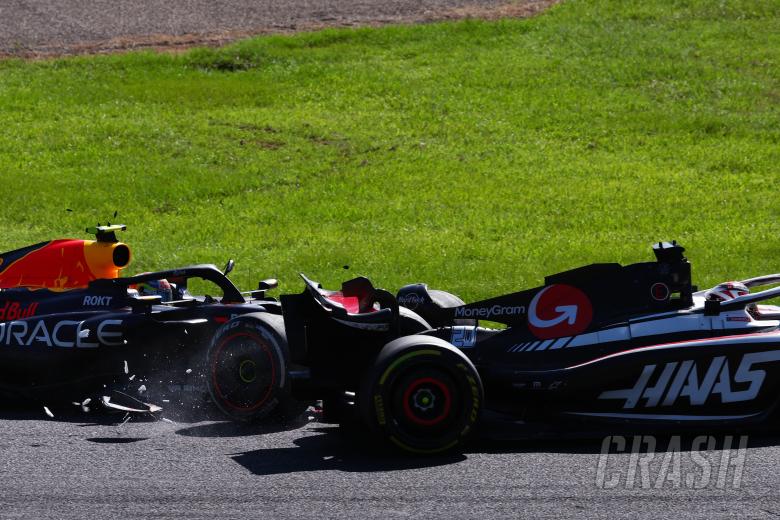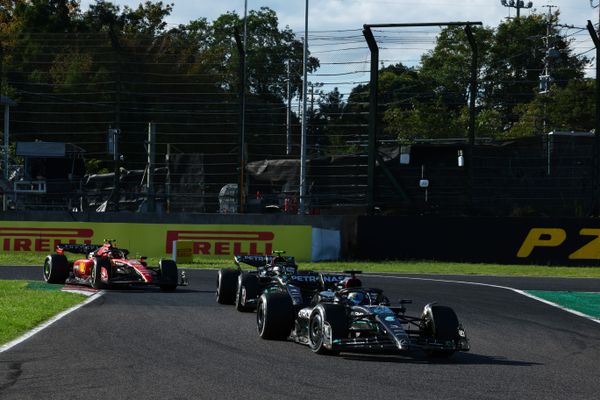MERCEDES WAS RIGHT TO DENY RUSSELL’S HAMILTON TEAM ORDER WISH.
The Japanese Grand Prix showed Lewis Hamilton and George Russell are finally delivering on some of the intra-team fireworks that the formation of such a tantalisingly good Formula 1 driver line-up promised last year.
They went line astern fighting Ferrari for victory last weekend in Singapore and while in Japan the positions they were fighting for were lower, the intensity of their team radio frustration was arguably even greater.
The Race understands it was Mercedes team principal Toto Wolff who ultimately ruled that Russell let Hamilton through in the closing stages when the strategists were debating whether to order a reversal of the cars or agree to Russell’s request that Hamilton stay behind until the last lap so they could resist Carlos Sainz’s Ferrari together.
The broadcast of fraught radio traffic over that situation and an almost-messy earlier wheel-to-wheel battle put a new spotlight on Russell and Hamilton’s relationship. While their very sensible post-race comments played it all down, it didn’t make what unfolded during the race any less fascinating. And ultimately Mercedes played this one right.
THE LATE RACE TEAM ORDER.
Russell was the only driver to attempt a single stop and was holding fifth place on old hard tires when he was caught by teammate Hamilton – whose new hard was 10 laps over – with eight laps remaining.
Hamilton warned his Mercedes team that “we will lose these two positions” if Russell did not let him pass. Then, just one lap later, Hamilton reassured: “George has received the order, we will change positions in turn 1.”
But Russell wasn’t very enthusiastic.
“Why not reverse in the last round and he just stays in DRS like last week unless he fights for a better result?” came the plea. But the decision has been made:
“So that’s the instructions, George, change positions.” That’s because this was a different situation to Singapore, where Sainz tried to drag the McLaren of surprise ally Lando Norris so they could both hold off the pursuing Mercedes drivers.
Overtaking there was much harder than at Suzuka, where a good tire advantage – which Hamilton and Sainz had over Russell – was the ticket for comfortable overtaking throughout Sunday.
Mercedes – and Wolff – realize this and clearly don’t want to risk Sainz chasing both cars, even if it means Russell becomes an easy kill for Sainz as a result.
Mercedes had already forecast this logic on Saturday evening too with Andrew Shovlin admitting “we’re getting to a stage of the championship where strategically we’re going to have to keep an eye on Ferrari”.
It was the safer, pragmatic choice and all but guaranteed Mercedes had a car finishing ahead of one Ferrari, minimising the swing in the constructors’ championship with Ferrari clipping Mercedes’ margin in second place from 24 points to 20.
On the lap after he overtook his team-mate, Hamilton did slow down enough through 130R to give Russell DRS to defend against Sainz but Russell was also limping relatively by the time of the chicane. The tyres cried out when he got on the throttle out of the chicane and Sainz easily had him on the run to Turn 1.
“We wasted all that time for no reason,” was Hamilton’s initial verdict over the radio and he doubled down on that after the race.

WHAT THE DRIVERS FELT AFTERWARDS.
“If we had inverted [earlier] maybe George would have had a better time holding [Sainz] behind,” Hamilton said.
“But because he was trying to fight me, damaging my tyres, I think it just made it all complicated.
“The fact is we’re not fighting each other in the drivers’ championship, as drivers it’s not important where we are, what’s important is that one of us finishes ahead of the Ferrari to keep the position.
“So today we really needed to work as a team.”
He added that “it made no sense” for him to give Russell DRS because Hamilton “needed to get as far clear ahead as possible”.
After the race, Russell conceded his tyres “were toast by the end” and said there were “zero hard feelings” and that “the team made the right call”.
He reiterated Hamilton and the team’s view that the constructors’ fight versus Ferrari takes precedence over their own intra-team scrap.
Russell passed Hamilton in the race at the end of lap five only for Hamilton to pass him again on the straight with a speed difference that confused Russell:
“I really don’t know how we failed.”
THE EARLY DICE.
Of course, that didn’t stop Russell and Hamilton from racing each other strongly at the start of the Grand Prix, with the Mercedes drivers nearly coming to blows.
Then, at the end of Hamilton’s first race, he pulled out of Degner 2 – after struggling there throughout the race due to damage on the first lap – and allowed Russell to watch the big left-hander of Spoon in front of the right back.
Hamilton almost made it through that corner with worn tires and that left Russell with no choice but to go off the track.
“Who do we want to fight here? Is it each other or is it each other? was Russell’s exasperated radio response.
And that was still on Russell’s mind at the end of the race when he needed Hamilton to give him DRS after letting him pass:
“[Hamilton needs] to play the team game [and give me DRS], he pushed me off the track before, that’s the least he could do.”
Russell had cooled after the race, brushing it off as “just hard, fair racing” and calling his team radio a “release valve because it’s so hot in the car, it’s a long race, you’re there pushing for an hour and a half, you’re fighting every inch”. Hamilton admitted he was “definitely aggressive” but agreed it was “good racing”
DOES ALL THIS COST MERCEDES ANYTHING?
In the end, both drivers met with disaster, but it is difficult to show conclusively that skirmishes at the beginning of the race or team orders at the end of the race caused them to lose significant positions. in the race.
The team took a pragmatic and cautious approach, allowing its riders to race early and then intervening later to secure the positions they thought they could.
Russell keeping Hamilton in his DRS would ultimately be a riskier, higher reward approach, which could have the downside of seeing the faster Mercedes lose if it leaves Hamilton takes time and makes him more vulnerable to Sainz when he doesn’t need It. used to. Letting Hamilton pass increases Sainz’s chances of overtaking Russell but reduces Sainz’s chances of overtaking Mercedes as well. Sainz admitted that when he saw the Mercedes in front of him, he assumed they would work towards giving each other DRS and felt it might make his life more difficult.
When asked what he thought about what Mercedes should have done, he replied “To be honest, they probably would have had a better chance if Lewis had stayed”, but then, thinking about that situation , he felt that Mercedes could have given him the position to hold. better chance of overtaking both – especially as he felt it was unrealistic to overtake Hamilton on track under normal conditions given their relative speeds.
“I would have tried to attack Lewis [if he had stayed],” Sainz said.
“George was very slow on the essays and it was 9/8, so I tried on paper 11 because they were both very slow on that part.

“We will never know but I think it would have been more dangerous to leave Lewis behind, because if I had married Lewis I would have also married George. And the near misses early in the race actually didn’t cost either driver much racing time – a second or two at most. It will make no difference to Charles Leclerc’s chances of challenging for fourth place, and Sainz will still catch them in the end.
Beating Ferrari is clearly the priority for the team but that’s never going to stop two hungry drivers from fighting tooth and nail for every position in the heat of the moment, particularly given the current dynamic at Mercedes.
Russell is frustrated having – by his own admission – far from the season he wanted with his position in the drivers’ championship now “out of the window totally” given he’s 75 points behind Hamilton.
Both drivers are signed through to the end of 2025 so Russell has long been well aware that he’s going to have to wrestle the edge over Hamilton rather than simply waiting for him to retire and slot comfortably into the ‘team leader’ role.
That’s inevitably going to cause further tension and flashpoints further down the road.
For now, both drivers and the team are toeing the line well and keeping on the right side of the thin line between a good-natured elbows-out intra-team rivalry and an intra-team implosion. Even if it doesn’t always sound like it on team radio.






